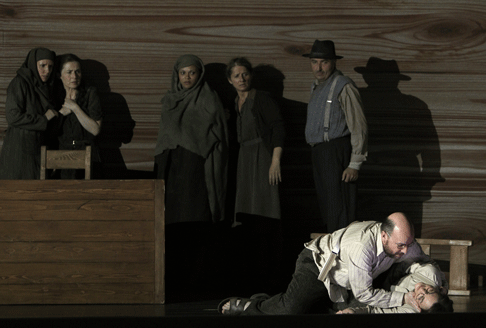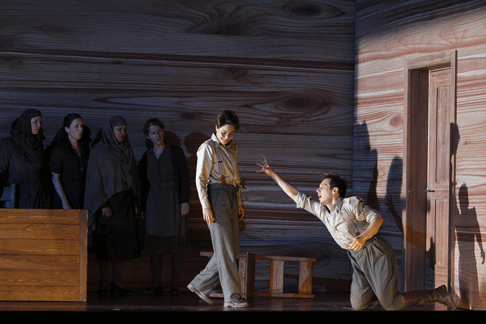It was an oratorio, David et Jonathas, by Marc-Antoine Charpentier who created between the acts tableaux for MoliËre comedies before Louis XIV banned frivolous entertainments, like plays and opera. Thus theater, never to be suppressed, moved to the concert hall where bible stories were told. That they were really operas anyway was a secret no one told.
David et Jonathas is about two boys who love each other passionately (that’s the David of the Goliath story by the way, and Jonathas, son of Saul) . And yes, there was a prolonged kiss in the Aix staging by Andreas Homoki, lately intendant of Berlin’s Komishe Oper, coming in as that of Zurich Opera. William Christie and his Les Arts Florisants orchestra were in the pit, about forty musicians, including 24 strings to provide a big, lush sound and winds and percussion to add seemingly infinite colors. The wind roll and thunder sheet, both exceptionally well played, made the case for the virtuosity of this famed early music ensemble.
In concert with all this fire power were its three principal singers, Pascal Charboneau as David, Ana Quintans as Jonathas and Neal Davies as Saul, who delivered the maximum rapture, agony and rage that any drama of the Baroque could possibly conjure. There can be no way to hear how this music sounded long ago, but the suspicion lurks that three centuries of operatic progress have layered bel canto, verismo and expressionism onto what singing once was. These singers gave us all of this.

In these voices the usual vocal technique of floating a tone on a column of air gave way (it seemed) to singing on the chords (the vocal chords), like shouting (or screaming) where the vocal urgency is apparent. Of course exercised by these artists it was singing at its most dramatic. And seventeenth century Catholic priest librettist PËre FranÁois de Paule Bretonneau gave Charpentier’s singers a lot to sing about.
In the Homoki staging David, an outcast of both the Jews and the Philistines, has been taken into the bosom of Saul’s household, the en famille dinner table. The silent mother, first portrayed by an actress and later brilliantly sung by identically costumed counter-tenor Dominique Visse provides the love, Saul is consumed by suspicions, obsessed that David is a powerful rival. Homoki introduced the innocence and intensity of the David/Jonathas relationship in the overture with two young boys happily playing in Saul’s home. These young boys, wonderful actors, later in the opera may have sung a brief duet as their lips moved though no sound was apparent.
Homoki gently and succinctly portrays the crisis in Saul’s mind and kingdom (Saul’s family) by pantomiming the death of the mother. But the mother transformed into the witch Pythonisse, now Mr. Visse, who appears to torment Saul in a lengthy scene where her presence is inexorably intensified by ten (or so) identical mothers. Mr. Visse rendered this scene otherworldly in an operatic voice that is feminine but is not. It was the voice of a witch.

Young Canadian tenor Pascal Charboneau as David compelled us to suffer the death of Jonathas, his love, to be trapped in his complex feelings for his surrogate father and sworn enemy Saul and to understand his emotional desolation at his coronation as the bible’s King David. Mr. Charboneau is a dynamic performer who has yet to gain final finish though this roughness added to his performance. Portuguese soprano Ana Quintans as Jonathas made time stand still in her lament that she (Jonathas) must forsake her love for David, the eternal nature of such love expressed in suspended tones floating above the staff. Mlle. Quintans is a quite polished singer and actress. English baritone Neal Davies made Saul both a conflicted, more or less contemporary Orthodox Jew pater familias and a conflicted political leader. Stabbed by David he lay seemingly dead through an extensive scene until resurrected by rage he made a final, extensive, spine tingling, vocally splendid lunge at David to avenge the death of his son.
Mr. Homoki with his designer, architect Paul Zoller played on the concert genesis of the opera by constructing a huge wooden box, like a concert stage. It was however a sentient machine that expanded and contracted in concert with the drama and its music, its side walls moving in to crush Saul as he learns that God has forsaken him. Its walls again move in to crush Jonathas when he must decide if he will forsake his duty to his father for the sake of his love for David. The costumes by Gideon Davey were brilliantly simple, a timeless modern adaptation of Orthodox dress and an adaptation of the Arabic thwab.
Not to forget to extol the exemplary performance by Les Arts Florisants chorus, both individual voices in solo lines and the scenes with full chorus. Not only did this fine ensemble find the urgency and excitement of opposing populations in its vocal projection, its members physically embodied the action in stance and movement. It was an opera chorus performance of stellar accomplishment.
Michael Milenski
Click here for broadcast information.
image=http://www.operatoday.com/DAVID534a.gif
image_description=David et Jonathas at the Aix Festival
product=yes
product_title=Marc-Antoine Charpentier: David et Jonathas
product_by=David: Pascal Charbonneau; Jonathas: Ana Quintans; Sa¸l: Neal Davies; Achis: FrÈdÈric Caton; Joabel: Kreöimir äpicer; La Pythonisse: Dominique Visse; Samuel: Pierre BessiËre. Chorus and Orchestra: Les Arts Florissants. Conductor: William Christie; Mise en scËne: Andreas Homoki; Scenery: Paul Zoller; Costumes: Gideon Davey; Lighting: Franck Evin. ThÈ‚tre ArchevÍchÈ, Aix-en-Provence. (July 11, 2012)
product_id=Photos copyright Pascal Victor / Artcomart, courtesy of the Aix Festival